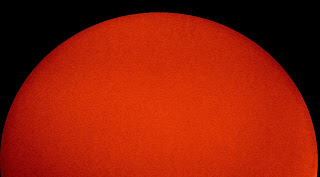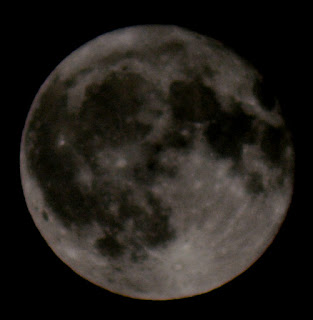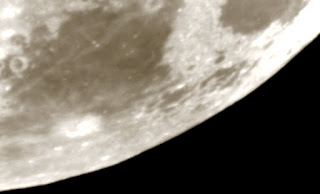September 29th 2230 GMT
I did a session with the Moon and the Bresser Electronic
Eyepiece. It seemed to go well but Mars was partially shrouded in cloud and the
air was very unsteady.
September 29th 2010 GMT
After shooting a few darks, I aimed my camera at Vega. I
used 70mm focal length, ISO 6400 and 10 seconds’ exposure. I wanted a
constellation shot but was also hoping for a meteor or few.I missed Lyra but caught a meteor.
September 29th 1225 GMT
I checked the Sun in a clear sky. There appeared to be some
features on the disc.
September 28th 2130 GMT
Evening conditions had changed little from the preceding
days. I snapped a few frames of the Moon with my DSLR.
The
Pleaides (M45) were in a misty area of sky and showed about a dozen stars
through my binoculars. The Andromeda Galaxy (M31) looked surprisingly good
under the conditions and I could see some albedo features in the central bulge.
September 27th 2050 GMT
There was lots cloud about but I was able to get some shots
of the Moon with my DSLR.
September 27th 1115 GMT
The
Sun was quiet again, even in hydrogen alpha light but I took a few full disc
frames and close-ups. This time, I used a lens shield on my camera. I only caught two quadrants but was quite pleased with the result.
September 27th 0545 GMT
The waning gibbous moon was high in the west, so I snapped a
few frames with my DSLR.
September 26th 2020 GMT
I had time for a quick session but I still had a few things
to do before bedtime. As the Moon was up, I took a few full disc shots with my
DSLR. I stacked the best 12 frames.
I decided to have a binocular scan, as deep sky photography
was out of the question. I started off with the Wild Duck Cluster (M11), a
possible target for clearer nights. Saturn showed its rings but I could not
quite make out the gap between the rings and planets.
Mars showed a disc, that was all. Melotte 20 was nicely
placed and looked great, despite the moonlight. I could even see the Pleaides
(M45) low in the east and I had to “trespass” on my neighbours’ lawns to get it
above the trees. I finished with the Andromeda Galaxy (M31) and could even make
out some structure.
September 26th 1110 GMT
I checked the Sun with my PST. Although I could not see any
prominences, the disc looked quite active. I tried some quadrant shots in
addition to the full disc ones. Thew results showed that I needed more practice but I still uncovered some details that were not visible in the full disc image.
September 25th 2015 GMT
There was quite a bit of cloud about so I just did some DSLR
lunar shots.
September 25th 1115 GMT
Visually, there were some albedo features on the solar disc,
so I hoped for something interesting on the photos.
September 24th 2025 GMT
As I needed an early night, I just took some full disc shots
of the Moon with just the DSLR.
September 24th 1020 GMT
The Sun was quiet in hydrogen alpha light again.
September 23rd 2130 GMT
The Moon was nearly full and had cleared our house, as seen
from the back garden. I started off with a few dozen exposures with my Mak and
DSLR. I used 1.54m focal length, ISO 100 and 1/1000 second exposure.
I took a few runs with my Mak and Bresser Electrronic
Eyepiece, then turned my attention to Mars. I could clearly see it on my laptop
screen! I saw what looked like some albedo features and an ice cap, then my PC
crashed.
I restarted my PC and did a few imaging runs of Mars and
seemed to catch something. Although the disc was small, I caught some albedo features, with the third effort being the best.
I then revisited the Moon until my laptop froze and I was
starting to freeze myself. I decided to quite while I was ahead.
September 21st 0925 GMT
There was some moving cloud but the forecast for later was
worse. Therefore, I grabbed a shot of the Sun, even though it was (again!)
quiet.
September 17th 2025 GMT
The sky was clear but I had an early start the next day. I
took some snaps of the Moon with Saturn then some of the Moon alone.
I combined the two to get this.
September 17th 1455 GMT
I
had some rare clear sky, so snapped the Sun in hydrogen alpha light. There
appeared to be some shading.
September 15th 0820 GMT
The
weather forecast for later was bad, so I did an early solar hydrogen alpha
shoot. I could not see any detail visually, so I hoped that my camera might
reveal something. It took some time but managed to catch a nice filament.
September 13th 1945 GMT
I popped out to have a look and found that the Moon was too
low for telescopic photography but I could snap it using a hand-held DSLR. Unfortunately, none of the shots worked.
I then re-tried the pole shot from the night before. I managed to hit the right spot.
September 12th 2015 GMT
I decided to have another go at the polar regions. I used
ISO 6400, 300mm focal length and 10 seconds exposure. I started off with some
dark frames.
I missed Polaris but caught a meteor on film.
... and another one.
I stacked the first hundred photos but had to use Microsoft ICE, as Deep Sky Stacker did not like my images.
I was convinced that one trail was a satellite, rather than a meteor but I was not sure what this was.
I managed to stack the last 51 images to get a deep image of the region.
September 12th 2006 GMT
I was surveying the sky, looking for potential targets when
I saw a meteor in the corner of my eye. It was in the Cygnus/Aquila area, so
may have been a Kappa Cygnid.
September 9th
It was nice to have some clear sky again but the Sun was still quiet.
September 7th 0650 GMT
The
Sun had cleared the trees but was still quiet.
September 7th 0545 GMT
I
snapped a thin crescent moon with my DSLR.
September 29th 2230 GMT
I did a session with the Moon and the Bresser Electronic
Eyepiece. It seemed to go well but Mars was partially shrouded in cloud and the
air was very unsteady.
September 29th 2010 GMT
After shooting a few darks, I aimed my camera at Vega. I
used 70mm focal length, ISO 6400 and 10 seconds’ exposure. I wanted a
constellation shot but was also hoping for a meteor or few.I missed Lyra but caught a meteor.
September 29th 1225 GMT
I checked the Sun in a clear sky. There appeared to be some
features on the disc.
September 28th 2130 GMT
Evening conditions had changed little from the preceding
days. I snapped a few frames of the Moon with my DSLR.
September 27th 2050 GMT
There was lots cloud about but I was able to get some shots
of the Moon with my DSLR.
September 27th 1115 GMT
September 27th 0545 GMT
The waning gibbous moon was high in the west, so I snapped a
few frames with my DSLR.
September 26th 2020 GMT
I had time for a quick session but I still had a few things
to do before bedtime. As the Moon was up, I took a few full disc shots with my
DSLR. I stacked the best 12 frames.
I decided to have a binocular scan, as deep sky photography
was out of the question. I started off with the Wild Duck Cluster (M11), a
possible target for clearer nights. Saturn showed its rings but I could not
quite make out the gap between the rings and planets.
Mars showed a disc, that was all. Melotte 20 was nicely
placed and looked great, despite the moonlight. I could even see the Pleaides
(M45) low in the east and I had to “trespass” on my neighbours’ lawns to get it
above the trees. I finished with the Andromeda Galaxy (M31) and could even make
out some structure.
September 26th 1110 GMT
I checked the Sun with my PST. Although I could not see any
prominences, the disc looked quite active. I tried some quadrant shots in
addition to the full disc ones. Thew results showed that I needed more practice but I still uncovered some details that were not visible in the full disc image.
September 25th 2015 GMT
There was quite a bit of cloud about so I just did some DSLR
lunar shots.
September 25th 1115 GMT
Visually, there were some albedo features on the solar disc,
so I hoped for something interesting on the photos.
September 24th 2025 GMT
As I needed an early night, I just took some full disc shots
of the Moon with just the DSLR.
September 24th 1020 GMT
The Sun was quiet in hydrogen alpha light again.
September 23rd 2130 GMT
The Moon was nearly full and had cleared our house, as seen
from the back garden. I started off with a few dozen exposures with my Mak and
DSLR. I used 1.54m focal length, ISO 100 and 1/1000 second exposure.
I took a few runs with my Mak and Bresser Electrronic
Eyepiece, then turned my attention to Mars. I could clearly see it on my laptop
screen! I saw what looked like some albedo features and an ice cap, then my PC
crashed.
I restarted my PC and did a few imaging runs of Mars and
seemed to catch something. Although the disc was small, I caught some albedo features, with the third effort being the best.
I then revisited the Moon until my laptop froze and I was
starting to freeze myself. I decided to quite while I was ahead.
September 21st 0925 GMT
There was some moving cloud but the forecast for later was
worse. Therefore, I grabbed a shot of the Sun, even though it was (again!)
quiet.
September 17th 2025 GMT
The sky was clear but I had an early start the next day. I
took some snaps of the Moon with Saturn then some of the Moon alone.
September 17th 1455 GMT
September 15th 0820 GMT
September 13th 1945 GMT
I popped out to have a look and found that the Moon was too
low for telescopic photography but I could snap it using a hand-held DSLR. Unfortunately, none of the shots worked.
I then re-tried the pole shot from the night before. I managed to hit the right spot.
September 12th 2015 GMT
I decided to have another go at the polar regions. I used
ISO 6400, 300mm focal length and 10 seconds exposure. I started off with some
dark frames.
I missed Polaris but caught a meteor on film.
... and another one.
I stacked the first hundred photos but had to use Microsoft ICE, as Deep Sky Stacker did not like my images.
I was convinced that one trail was a satellite, rather than a meteor but I was not sure what this was.
I managed to stack the last 51 images to get a deep image of the region.
September 12th 2006 GMT
I was surveying the sky, looking for potential targets when
I saw a meteor in the corner of my eye. It was in the Cygnus/Aquila area, so
may have been a Kappa Cygnid.
September 9th
It was nice to have some clear sky again but the Sun was still quiet.
September 7th 0650 GMT
September 7th 0545 GMT
September 6th 0505 GMT
I did a dawn raid on the Moon with my DSLR.
September 3rd 1100 GMT
At last some clear sky when I was at home!
The Sun was quiet yet again, even in hydrogen alpha light.
I also took some snaps of the Moon with my DSLR, although
there was a lot of haze. It took a lot of processing to get any detail at all.



































































No comments:
Post a Comment